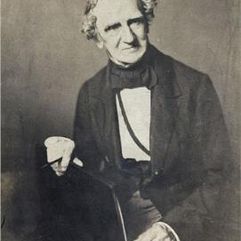

Thomas Sully
1783 - 1872
Thomas Sully was an English-American portrait painter. He was born in England, became a naturalized American citizen in 1809, and lived most of his life in Philadelphia, Pennsylvania, including in the Thomas Sully Residence. He studied painting in England under Benjamin West. He painted in the style of Thomas Lawrence and has been referred to as the "Sir Thomas Lawrence of America".
He produced over 2,300 paintings over his 70 year career. His subjects included United States presidents Thomas Jefferson, John Quincy Adams, and Andrew Jackson; Revolutionary War hero General Marquis de Lafayette, and Queen Victoria. In addition to portraits of wealthy patrons, he painted landscapes and historical pieces such as the 1819 The Passage of the Delaware. His work was adapted for use on United States coinage.
Career
Sully became a professional painter at age 18 in 1801, while living in Norfolk, Virginia, with his brother Lawrence. By 1802, he and elder brother Lawrence Sully changed their base to Richmond, Virginia, where they continued to work together. In 1805, Thomas Sully married his brother's widow, Sarah (Annis) Sully. He took on the rearing of Lawrence's children.
Sully moved to New York in 1806. The next year, he studied portrait painting under Gilbert Stuart in Boston for three weeks. By 1808, he had settled in Philadelphia, where he resided for the remainder of his life. He received his American citizenship on May 17, 1809, and soon after traveled to London for nine months of study under Benjamin West, who had established his painting career in London. Sully also befriended the portrait painter Charles Bird King who was also studying under West in London.
West had stopped painting portraits and encouraged Sully to study the work of portrait artists he admired. Sully formed a friendship with Thomas Lawrence, whose influence was so profound that Sully came to be known as the "Sir Thomas Lawrence of America." Sully returned to the U.S. in 1810.
Sully's 1824 portraits of John Quincy Adams, who became President within the year, and the general Marquis de Lafayette, brought him widespread recognition. His Adams portrait is held in the National Gallery of Art, Washington. Many notable Americans of the day had their portraits painted by him. In 1837-1838, he was in London to paint Queen Victoria at the request of the St. George Society of Philadelphia. His daughter Blanche assisted him as the Queen's "stand-in," modeling the Queen's costume when she was not available. One of Sully's portraits of Thomas Jefferson is owned by the Jefferson Literary and Debating Society at the University of Virginia and hangs in that school's rotunda. Another Jefferson portrait, this one head-to-toe, hangs at West Point, as does his portrait of General Alexander Macomb.
Sully taught portrait painting to Marcus Aurelius Root, who later became an internationally successful daguerreotypist. Other students of his included Jacob Eichholtz, Charles Robert Leslie and John Neagle.
Sully was a prolific artist and produced more than 2,300 paintings over the course of his seventy year career. His style resembles that of Thomas Lawrence.(cf. Rilla Evelyn Jackman "AMERICAN ARTS" 1928 pg. 61) Though best known as a portrait painter, Sully also made historical pieces and landscapes. An example of the former is the 1819 The Passage of the Delaware, now in the Museum of Fine Arts, Boston.
Text courtesy of Wikipedia, 2025



































